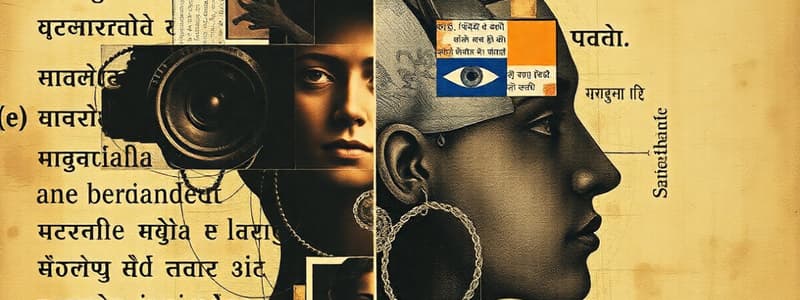Podcast
Questions and Answers
What does the term 'Sanskrit' mean?
What does the term 'Sanskrit' mean?
- Religious text
- Refined or cultured (correct)
- Ancient language
- Systematic grammar
Which form of Sanskrit is considered the oldest?
Which form of Sanskrit is considered the oldest?
- Vedic Sanskrit (correct)
- Post-Classical Sanskrit
- Classical Sanskrit
- Modern Sanskrit
What is the highest standardization of Sanskrit attributed to?
What is the highest standardization of Sanskrit attributed to?
- Ashvagosa
- Kalidasa
- Panini (correct)
- Yaska
How many phonemes are there in the phonetic system of Sanskrit?
How many phonemes are there in the phonetic system of Sanskrit?
Which of the following texts is NOT considered a main text of Sanskrit literature?
Which of the following texts is NOT considered a main text of Sanskrit literature?
Flashcards are hidden until you start studying
Study Notes
Overview of Sanskrit
- Ancient Language: Sanskrit is one of the oldest languages in the world, originating in India.
- Etymology: The term "Sanskrit" means "refined" or "cultured."
Historical Context
- Origins: Dates back over 3,000 years.
- Vedic Sanskrit: The oldest form, found in the Vedas (sacred Hindu scriptures).
- Classical Sanskrit: Standardized around 500 BCE, primarily through the work of Panini, a grammarian.
Linguistic Features
- Indo-European Language Family: Related to languages like Latin, Greek, and Persian.
- Grammar: Highly systematic, with complex rules and an extensive system of inflection.
- Phonetics: Consists of 49 phonemes, including vowels and consonants.
Scripts and Dialects
- Scripts: Commonly written in Devanagari, also in Brahmi, and other regional scripts.
- Dialects: Various regional forms, including Prakrit.
Literature and Usage
- Literary Heritage: Rich body of texts, including poetry, drama, and philosophy.
- Main Texts: Includes the Rigveda, Upanishads, Mahabharata, Ramayana, and Puranas.
- Modern Usage: Used in Hindu rituals, classical music, and dance; also a medium of scholarly discourse.
Cultural Significance
- Religious Role: Key to Hinduism, Buddhism, and Jainism.
- Philosophy: Foundations for Indian philosophy; diverse schools developed from Sanskrit texts.
- Revival Efforts: Contemporary initiatives to teach and promote the language.
Summary of Key Characteristics
- Inflected Language: Rich in morphology with noun cases, verb conjugations, etc.
- Syntactical Flexibility: Word order can vary due to inflection.
- Cultural Symbol: Represents the philosophical and cultural heritage of India.
Sanskrit Origins and History
- Sanskrit is one of the oldest languages in the world, originating in India.
- Its name, "Sanskrit," means "refined" or "cultured."
- The oldest form of Sanskrit, Vedic Sanskrit, is found in the Vedas, sacred Hindu scriptures.
- Classical Sanskrit became standardized around 500 BCE, largely through the work of Panini, a renowned grammarian.
Linguistic Features of Sanskrit
- Sanskrit is part of the Indo-European language family, related to languages like Latin, Greek, and Persian.
- It has a highly structured grammar with complex rules and a vast system of inflection.
- Sanskrit comprises 49 phonemes, encompassing vowels and consonants.
Scripts and Dialects of Sanskrit
- Sanskrit is most commonly written in the Devanagari script.
- Other scripts used include Brahmi and regional scripts.
- Sanskrit has various regional forms, including Prakrit.
Literary and Cultural Significance of Sanskrit
- Sanskrit possesses a rich literary heritage, encompassing poetry, drama, and philosophy.
- Key works include the Rigveda, Upanishads, Mahabharata, Ramayana, and Puranas.
- Sanskrit remains used in Hindu rituals, classical music, and dance.
- It continues to be a medium for scholarly discourse.
- Sanskrit plays a crucial role in Hinduism, Buddhism, and Jainism.
- It laid the foundation for Indian philosophy, giving rise to diverse schools of thought.
- Contemporary efforts seek to revive and promote the study of Sanskrit.
Key Characteristics of Sanskrit
- Sanskrit is an inflected language, with rich morphology including noun cases, verb conjugations, etc.
- It exhibits syntactical flexibility, allowing for variations in word order due to inflection.
- Sanskrit represents the philosophical and cultural heritage of India, serving as a cultural symbol.
Studying That Suits You
Use AI to generate personalized quizzes and flashcards to suit your learning preferences.




